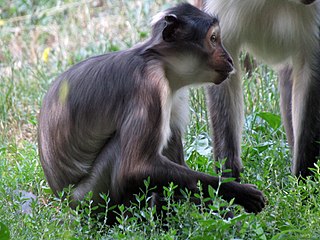
The International Union for Conservation of Nature (IUCN) Red List of Threatened Species, also known as the IUCN Red List or Red Data Book, founded in 1964, is an inventory of the global conservation status and extinction risk of biological species. A series of Regional Red Lists are produced by countries and organizations, which assess the risk of extinction to species within a political management unit.

The guenons are Old World monkeys of the genus Cercopithecus. Not all members of this genus have the word "guenon" in their common names; also, because of changes in scientific classification, some monkeys in other genera may have common names that include the word "guenon". Nonetheless, the use of the term guenon for monkeys of this genus is widely accepted.

The conservation status of a group of organisms indicates whether the group still exists and how likely the group is to become extinct in the near future. Many factors are taken into account when assessing conservation status: not simply the number of individuals remaining, but the overall increase or decrease in the population over time, breeding success rates, and known threats. Various systems of conservation status are in use at international, multi-country, national and local levels, as well as for consumer use such as sustainable seafood advisory lists and certification. The two international systems are by the International Union for Conservation of Nature (IUCN) and The Convention on International Trade in Endangered Species of Wild Fauna and Flora (CITES).

The white-eyelid mangabeys are African Old World monkeys belonging to the genus Cercocebus. They are characterized by their bare upper eyelids, which are lighter than their facial skin colouring, and the uniformly coloured hairs of the fur. The other two genera of mangabeys, Lophocebus and Rungwecebus, were once thought to be very closely related to Cercocebus, so much so that all the species were placed in one genus, but Lophocebus and Rungwecebus species are now understood to be more closely related to the baboons in genus Papio, while the Cercocebus species are more closely related to the mandrill.

An IUCN Red List Critically Endangered species is one that has been categorized by the International Union for Conservation of Nature as facing an extremely high risk of extinction in the wild. As of 2021, of the 120,372 species currently tracked by the IUCN, there are 8,404 species that are considered to be Critically Endangered.

A species that is extinct in the wild (EW) is one that has been categorized by the International Union for Conservation of Nature as known only by living members kept in captivity or as a naturalized population outside its historic range due to massive habitat loss.
N. occultus may refer to:

Taeniophallus is a genus of snakes of the family Colubridae.
Amnesteophis is a genus of snakes in the family Colubridae that contains the sole species Amnesteophis melanauchen. It is found in Brazil.
Nicagus obscurus is a species of stag beetle in the family Lucanidae. It is found in North America. Larvae can be found in the grooves of aspen driftwood. Adults emerge in August.
Dibernardia affinis is a species of snake in the family Colubridae. The species is native to Brazil.
Dibernardia bilineata is a species of snake in the family Colubridae. The species is native to Brazil.
Dibernardia persimilis is a species of snake in the family Colubridae. The species is native to Brazil.
Dibernardia poecilopogon is a species of snake in the family Colubridae. The species is native to Brazil, Uruguay, and Argentina.
Taeniophallus brevirostris, also known as the short-nosed ground snake, is a species of snake in the family, Colubridae. It is found in Brazil, Bolivia, Suriname, French Guiana, Colombia, and Peru.
Taeniophallus nebularis is a species of snake in the family, Colubridae. It is found only in Northern Venezuela. The species is classified as Critically Endangered on the IUCN 3.1 list.






